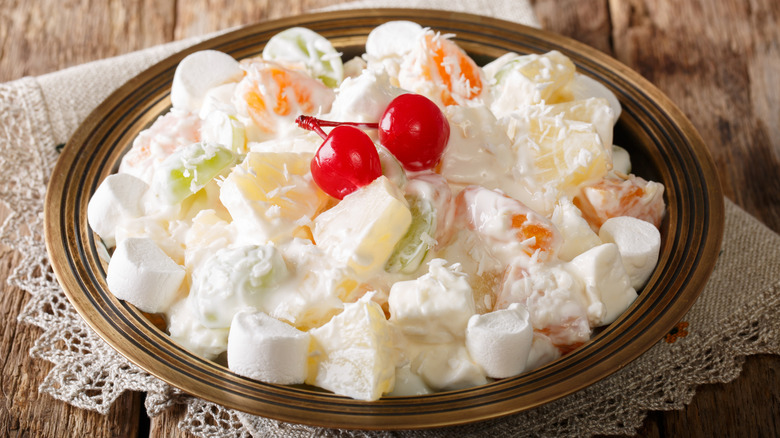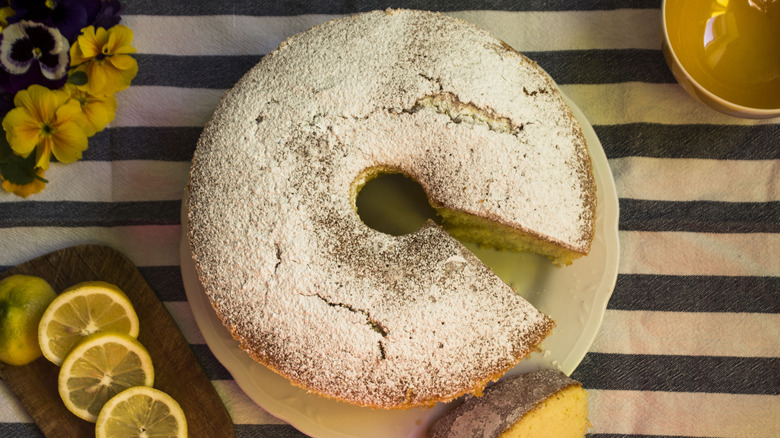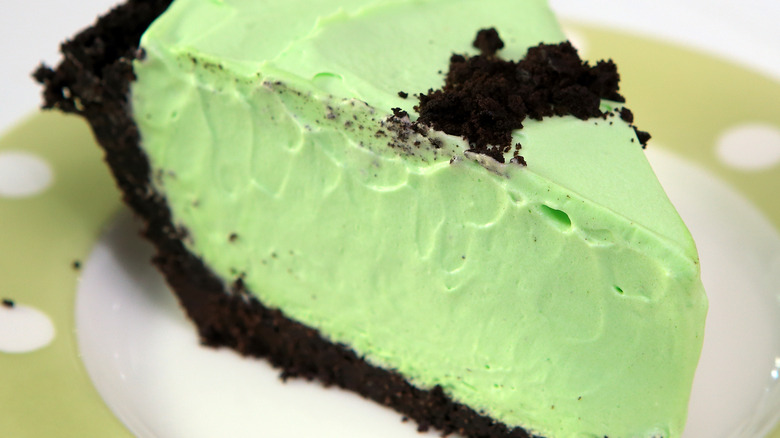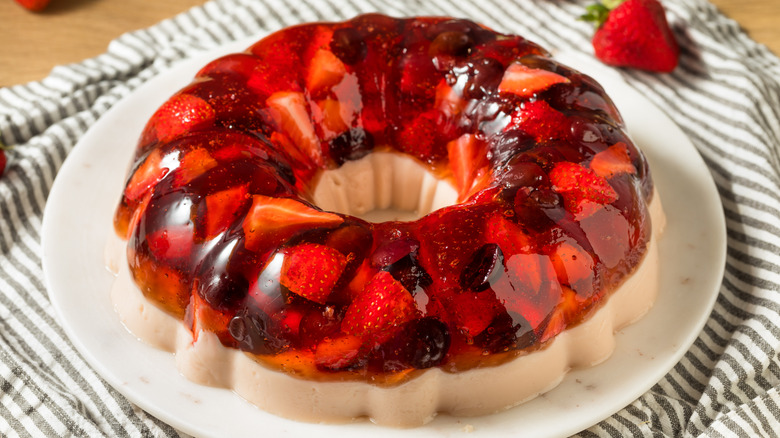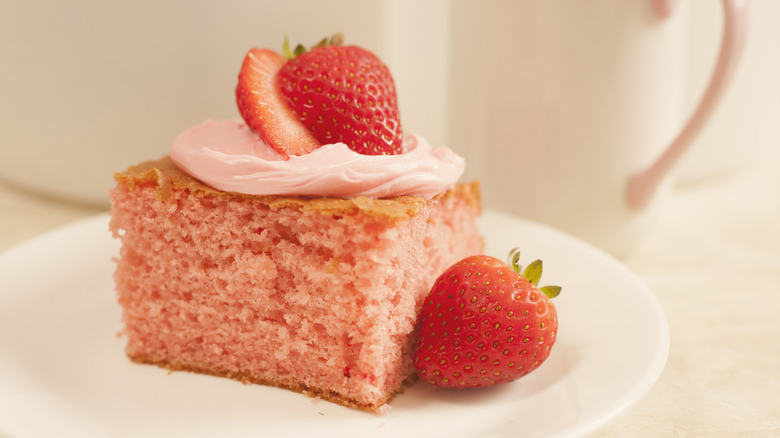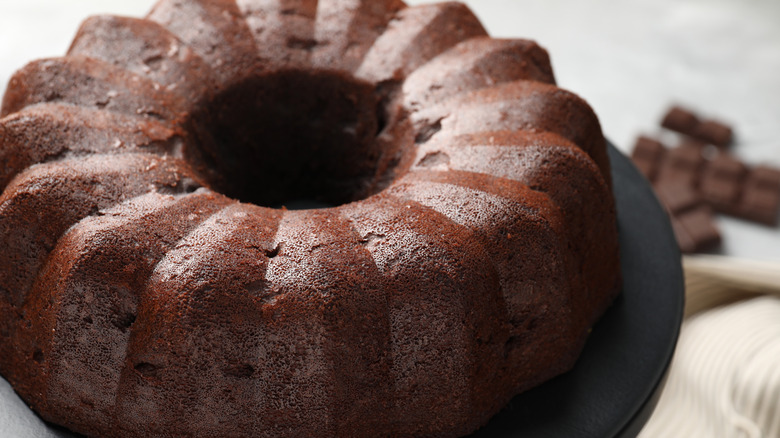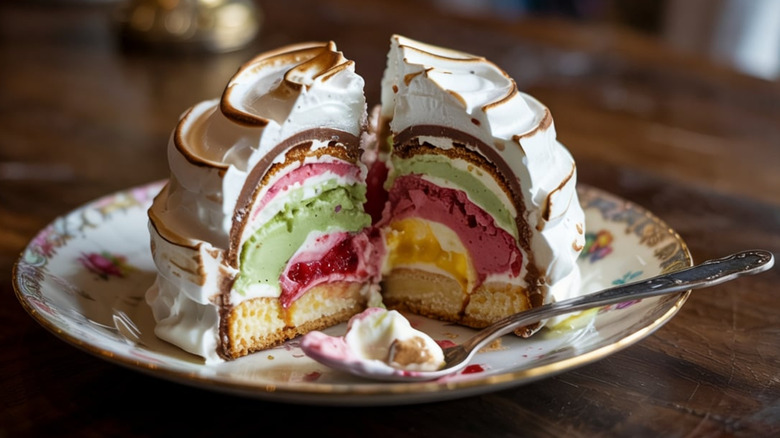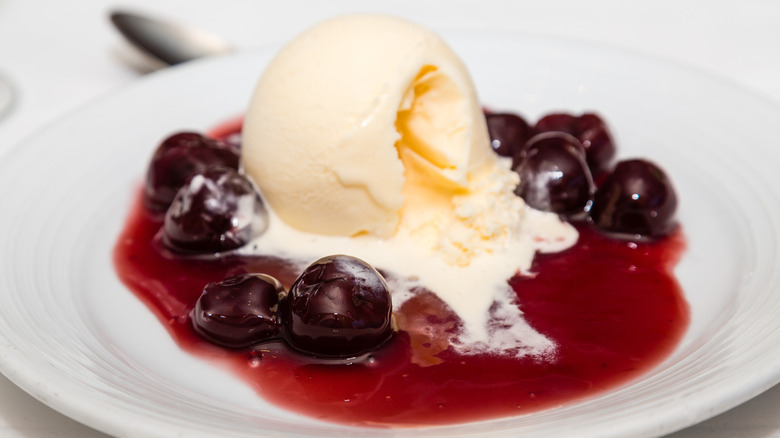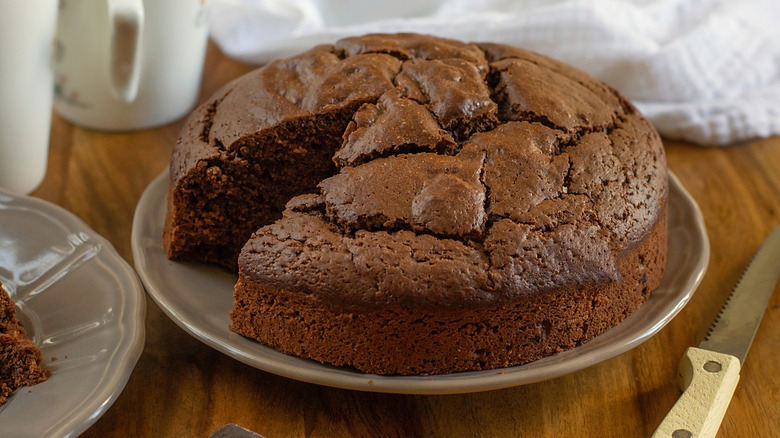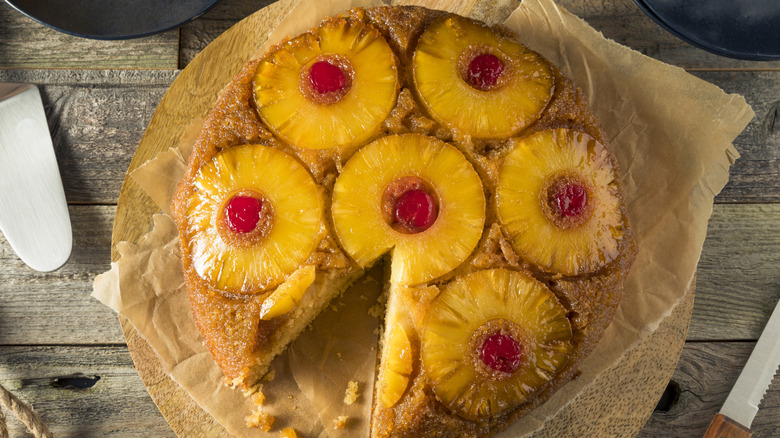10 Forgotten Desserts Your Grandparents Ate In The '50s & '60s
You'd think it would be hard for any kind of dessert to go out of fashion — it's dessert, after all — but as it turns out, it happens more than you might think. Take the desserts you'll find below, for example. They were popular in the '50s and '60s, so your grandparents probably enjoyed them many times, but they have since all but faded into the pages of time.
There's a slight chance you've heard of a few of the upcoming desserts before — some of them are currently having a resurgence — but we bet you haven't seen more than a couple on restaurant menus (if that) and certainly haven't tried them all. If you have, our guess is that it is probably only because your grandparents made them for you. It doesn't have to be that way, though, because once you learn about some of the nearly forgotten desserts from the '50s and '60s coming up, you might just want to try and make them yourself. Others not so much — chocolate mayonnaise cake? Yuck! Or is it? Regardless of whether or not the upcoming desserts make you start drooling enough to seek them out or attempt making them yourself, it's still cool to peek into ages past and get a glimpse at our elders' dessert-eating preferences, right? Let's go.
Ambrosia salad
The name ambrosia salad implies the dish is akin to the nectar of the gods, but we'll let you be the judge of whether or not it is worthy of such a title. Ambrosia salad is a fruit salad at its core. However, it also features coconut, marshmallow fluff, more marshmallows, and sometimes nuts. As for the fruit, basically anything canned will work, but in our experience, mandarin oranges and cherries are almost always included. Mix it all together and you get a sweet, marshmallow-y, coconut-y, fruit mix that is good enough to enjoy as a dessert.
Our grandmother used to make ambrosia salad for every holiday when we were growing up, so we can tell you that it is indeed a Southern tradition of the past. Has anyone in my family made it since? No, but times have changed, and when people think of fruit salad now, they imagine something quite a bit healthier than Ambrosia. Don't even get us started on how it's called a salad in the first place. Still, we remember loving it as a kid, and we were often told we weren't allowed to fill up on it alone. So, if you're looking to get a taste of some nostalgia, you could do a lot worse than recreating your grandparents' ambrosia salad.
Chiffon cake
Chiffon cake was invented by Harry Baker in 1927, who, interestingly enough, was an insurance salesman. It was an instant hit, but he kept his recipe secret for decades — gotta' corner the market, right? Eventually, in 1947, he sold his recipe for chiffon cake to General Mills so people everywhere could start making it themselves. At that point, its popularity spread like wildfire, and in the '50s, General Mills even hosted chiffon cake contests, cementing it into the baking culture of the era.
So, what makes chiffon cake stand out? Well, it may not look like anything special at first glance, but its appeal lies in the details. Instead of using shortening or butter, the recipe calls for vegetable oil. Additionally, the egg whites and yolks are whipped separately. The result is a light, airy cake with a delectable texture. When the recipe was first brought to the public, it was touted as revolutionary, but now cake recipes that call for vegetable oil are pretty common. That could be why chiffon cake has fallen by the wayside, but in its heyday, it was new, exciting, and unlike anything else. Considering it's hard to spot a chiffon cake by sight alone, it's possible you've had some before, even if it wasn't called as such.
Grasshopper pie
If you've ever sipped a classic grasshopper cocktail, which can be served as a martini or frozen, you already have a good idea of what a grasshopper pie will taste like. It's no coincidence they share the same name because the pie is actually based on the drink, and they share many of the same ingredients. Both are made with white crème de cacao, crème de menthe, and cream, resulting in a creamy, minty, chocolate-y concoction in a striking shade of green.
As for grasshopper pie specifically, the ingredients listed above are combined with melted marshmallow and whipped cream before it is poured into a chocolate crumb crust and chilled for several hours. Some recipes may opt for gelatin or egg whites over melted marshmallows, but either way, what you get is a bright green, fluffy dessert with lots of yummy flavor. Still, just like the cocktail that inspired it, grasshopper pie is no longer something you see on restaurant menus or dinner tables. It reached its peak popularity in the '60s, but you know what? Grasshopper pie might just be one of the classic pie flavors that deserves a comeback. Fluffy chocolate mint pie? Yes, please.
Jell-O molds
If you come from the land where ambrosia salad is popular, you've probably at least heard of a Jell-O mold before. If not, imagine a bundt cake made out of Jell-O with pieces of fruit floating inside, and you've got it. Pieces of meat or vegetables were not uncommon additions, either. They may sound somewhat lackluster or unusual today, but in the 1950s, they were wildly popular. Brightly-colored, glossy, jiggly, and almost futuristic in appearance, Jell-O molds were all the rage, and some would even say they were the most popular dish in post-war America. Not only did they exemplify the near-perfect appearance standards of the error, but they were also incredibly simple to make.
The futuristic appeal of Jell-O molds wasn't strong enough for it to maintain popularity for long; it started to decline in the '60s, but your grandparents probably loved them. If learning about Jell-O molds inspires you to try making one yourself, don't forget to use the hot water trick to help it release from the pan. Otherwise, all your hard work could crumble at the last moment, and this dessert is all about appearance. The term mold is in the name, after all.
Pink Champagne cake
In the 1960s, pink Champagne was a big hit, especially with lady socialites. It wasn't just the drink, either. The color itself was in fashion, so a crossover to a pink Champagne cake was an instant success. Made with layers of cake and Champagne-flavored Bavarian butter cream, it was not only delicious, but it looked the part, pink color and all. Can you imagine sipping pink Champagne while savoring a cake that matches in color and flavor? C'mon.
Even the name pink Champagne cake sounds fun, so whatever happened to it? Well, it may not be at its peak anymore, but it isn't completely gone, and considering pink sparkling wine is coming back into style, maybe the cake will start popping up again, too. Who knows? Also, if the name pink Champagne cake doesn't immediately have you singing Pink Pony Club in your head, do yourself a favor and give the song another listen — maybe while you attempt to make the cake? After all, it sounds perfect for any number of celebratory occasions.
Tunnel of fudge cake
The tunnel of fudge cake is the stuff of legends. While wildly popular in the 1960s, people today struggle to recreate it, almost as if it defies the laws of gravity or physics as a whole. Before we get into that, though, a tunnel of fudge cake is a chocolate and nut bundt cake with a ring of gooey fudge snaking through the middle. It's similar to the lava cake we know and love today, but on a much larger scale, hence the difficulty in getting it to bake properly.
In 1966, the tunnel of fudge cake recipe earned Mrs. Ella Helfrich second place in the Pillsbury Bake-Off competition, and from then on, its popularity reached soaring heights. In fact, it is still one of the most popular recipes ever in the Pillsbury Bake-Off competition. Even so, getting it made properly today is a nightmare, possibly because some of the original powder mixes have been discontinued. Regardless, if you want to give this cake a try, you're going to have to work hard to get it done right. Maybe your grandmother might have some tips? Or, maybe it is just best to stick to the modern lava cake version of the recipe.
Baked Alaska
Ice cream pies were very popular in the 1950s, and possibly the chicest one of all was the baked Alaska. It is believed that it was invented in the 1800s, although its origins are somewhat disputed, but it did not reach its peak popularity until the mid-20th century. Regardless, it consists of three main parts: a sponge or pound cake base, ice cream filling, and a toasted meringue shell formed into stunning peaks. Altogether, the components create a cake overflowing with various textures, flavors, and temperatures. It's simultaneously chewy, cool, creamy, and toasty — yum.
Of course, the whole peaked, flambé look of a baked Alaska is gorgeous, so how could it not be popular in your grandparents' era? Luckily, though, baked Alaska is having somewhat of a resurgence right now. That means its true glory days could still be yet to come. We will just have to wait and see. If you spot it on a menu, make sure to give it a try. It looks just as spectacular as it always has, but something tells us all the culinary innovations that have occurred since then will only make it that much tastier. Actually, we know so. We served it in a restaurant we worked at, and it was freaking phenomenal.
Cherries jubilee
In the 1950s and '60s, you could find cherries jubilee everywhere — in cookbooks, on restaurant menus, all over the place. The beauty of it was that it was simple to prepare, yet it came with a big, dramatic finish by way of fire. Essentially, cherries jubilee is made by sautéing the namesake ingredient with sugar and orange zest or juice. Once cooked to a gooey consistency, kind of like pie filling, brandy is added, and the entire thing is flambéed. After that, it is spooned into a bowl and served with a scoop of vanilla ice cream.
Cherries jubilee may be a fun dessert with lots of flourish, but its drama is also likely why it lost its appeal. In the '70s, the excess theatricality of the dessert fell out of fashion, so just like the baked Alaska, cherries jubilee was seen less and less. If you still love to flambé and have the tools to get the job done, cherries jubilee is easy and quick to make, so if you want to revisit some of your grandparents' favorites, it's a fantastic place to start. Safety first, though, and make sure to burn all of the alcohol off before serving, or the flavors will be all wrong, and you might just regret it the next day.
Chocolate mayonnaise cake
Unlike some of the other desserts on this list, chocolate mayonnaise cake was never wildly popular. It did, however, have a brief moment in the sun in the early 1950s. And no surprises here, but Hellman's Mayonnaise is credited with making it popular during that time.
The name chocolate mayonnaise cake isn't all that appealing, but if you think about it, mayo isn't too far off from the typical ingredients we see used in cake. After all, it does contain eggs, and it's creamy like oil or butter. That's exactly why it works so well in cake, so the chocolate mayonnaise cake swapping out butter and eggs for mayo works better than you might expect. Some early recipes also include nuts, dates, and raisins, but the use of mayo with chocolate cake batter is what's important.
Today, some people still use mayo in cake recipes to make the resulting dessert less greasy. You won't find anyone referring to it as chocolate mayonnaise cake, but the idea still stands and works exceptionally well. If you give it a try, we don't recommend telling people that's what you used until they get a taste, though. Otherwise, they might have a gut reaction to dislike it before they even give it a shot.
Pineapple upside down cake
If pineapple upside down cake makes you think of the iconic show "Mad Men," you are not wrong. Not only do the stars enjoy it in one of the episodes, but the mid-20th century was when it was most popular. As the name suggests, pineapple upside down cake is, in fact, flipped upside down at the very end, and that's what gives it its eye-catching appeal. To make one, a pan is lined with sugar and rings of pineapple. A cherry is typically placed in the center of each pineapple ring as well. Then, the cake batter is poured over the top, and it is baked. Once it comes out of the oven, it is flipped over so the caramelized fruit sits on top. And, yes, it is just as tasty as it looks.
Pineapple upside down cake isn't nearly as "forgotten" as some of the other desserts we've discussed thus far. It may not be the popular pick anymore, but it's another vintage dessert that's regaining traction in today's culinary landscape of desserts. If you've never had the pleasure of enjoying some before, keep an eye out for it or simply opt to make one yourself. As it turns out, it isn't all that difficult to make. The trickiest part is flipping it out of the pan after baking, and it isn't all that challenging if you let it cool for a bit and slide a knife around the edges beforehand.


